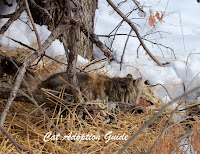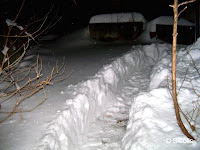Cats that live outside during the winter need shelter from the cold, snow and ice. Many people believe that the cat’s winter coat will provide adequate warmth.
The cat's fur will keep them warm, but if the temperatures dip below freezing the cat will be cold and if the cat is left outdoors, with no shelter or wind protection in extreme cold weather they will develop frost bite on paws, nose and ears.
Feral and stray cats need an insulated shelter to stay warm and dry in winter.
The cat's fur will keep them warm, but if the temperatures dip below freezing the cat will be cold and if the cat is left outdoors, with no shelter or wind protection in extreme cold weather they will develop frost bite on paws, nose and ears.
Feral and stray cats need an insulated shelter to stay warm and dry in winter.
Locating the Feral Cat Colony
Feral cats are terrified of humans and will go to the hallow trees and the thicket dens in the forest when the weather is bad. My husband and I decided to fill the hallow trees and thicket dens with straw as it would provide more insulation.
I decided to track the feral cat I call Bob in hopes to find the forest colony. I followed each of my colony cats by walking 20 feet behind them into the forest.
I found that the cats shelters, they were 107 feet south of my home; a hallow tree, a groundhog burrow, thicket den, shallow crevice in the limestone rock.
The stray cats lived closer, they had leaf shelters that were located under my neighbors low to the ground deck.
I noted the cat’s shelters and returned to the areas the following day when the cats weren't there. I brought insulation material; straw for their shelters. I set a thick pile of straw inside the hallow tree, burrow and thicket den.
The stray cats lived closer, they had leaf shelters that were located under my neighbors low to the ground deck.
I noted the cat’s shelters and returned to the areas the following day when the cats weren't there. I brought insulation material; straw for their shelters. I set a thick pile of straw inside the hallow tree, burrow and thicket den.
I spoke to my neighbor and informed him that the cat was using his deck for a shelter and asked if I could insulate it for the winter.
Insulating a deck is a little tricky because you never know what is living under it. I crawled under the deck and my husband handed me cardboard to set on the ground. I then piled a thick layer of leaves on top of the cardboard and topped the leaves with straw.
The top of the deck was covered with a plastic tarp that was secured tie downs. The tarp would provide a wind break and it would also prevent the water from getting the cats bellow wet. The home owner had no problem with the tarp on the deck because during the winter months it was seldom used.
About Sgolis, Feral Cat Colony Caregiver
Insulating a deck is a little tricky because you never know what is living under it. I crawled under the deck and my husband handed me cardboard to set on the ground. I then piled a thick layer of leaves on top of the cardboard and topped the leaves with straw.
The top of the deck was covered with a plastic tarp that was secured tie downs. The tarp would provide a wind break and it would also prevent the water from getting the cats bellow wet. The home owner had no problem with the tarp on the deck because during the winter months it was seldom used.
About Sgolis, Feral Cat Colony Caregiver
When the temperature dips into the teens I will provide shelter for the feral or stray cats by allowing them entrance to my shed or garage. I Installed a kitty door at the entrance. The door allows entrance to cats only and does not allow raccoon, dog or fox.
Inside the shelter I hang heavy blankets or insulated drapes over the windows and walls. For added warmth I cover the cement floor with cardboard or old carpet.
For cat bedding; I filled dish boxes with straw and gave the cats a fleece blankets I also provide the cats with self heating cat beds, mats and igloo and other insulated plastic cat houses.
Inside the shelter I hang heavy blankets or insulated drapes over the windows and walls. For added warmth I cover the cement floor with cardboard or old carpet.
For cat bedding; I filled dish boxes with straw and gave the cats a fleece blankets I also provide the cats with self heating cat beds, mats and igloo and other insulated plastic cat houses.
 |
| Insulated cat bedding inside shed: Image by Susan Golis |
Here is a video that will show you how to get your feral and stray cat shelters ready for winter:
Tips
- Keep cats warm by fueling their bodies with high protein food. The protein will give the cats the energy they need to keep them active during the winter months.
- Feed the cats daily and provide them with fresh water.
- To avoid freezing put cat's water in a heated bowl
- In winter season I feed outdoor cats dry food as the canned food will freeze. If cats are in the heated shed/shelter I will leave canned food for them.
- As long as an outdoor cat is in an area that
is dry, with some insulation, straw and a wind block the cat will adapt to living
outside during winter. The cats will sleep together and their bodies will keep them warm.

















